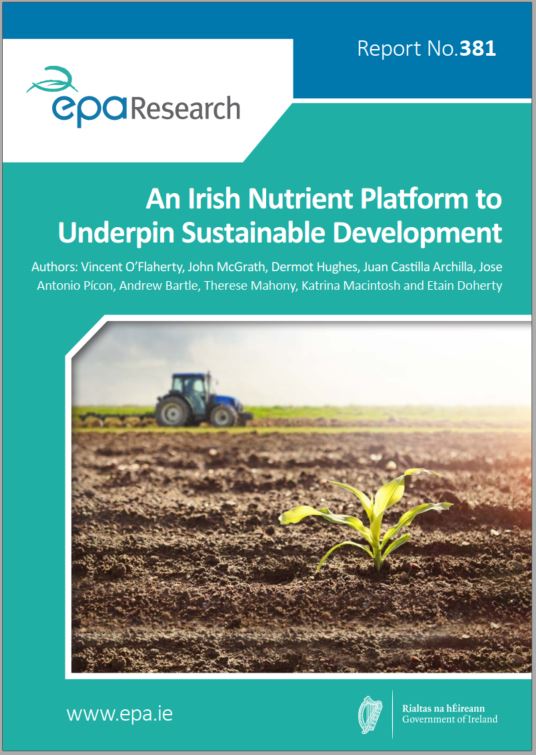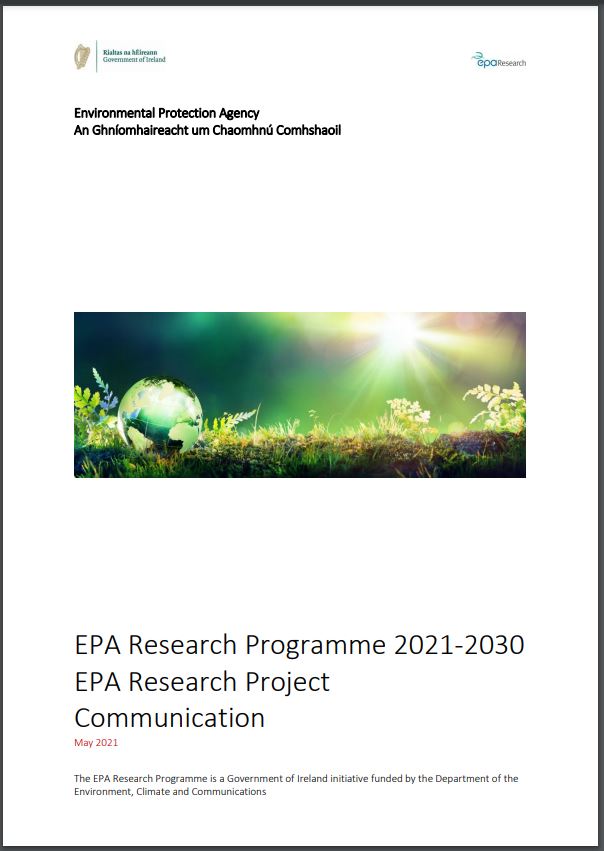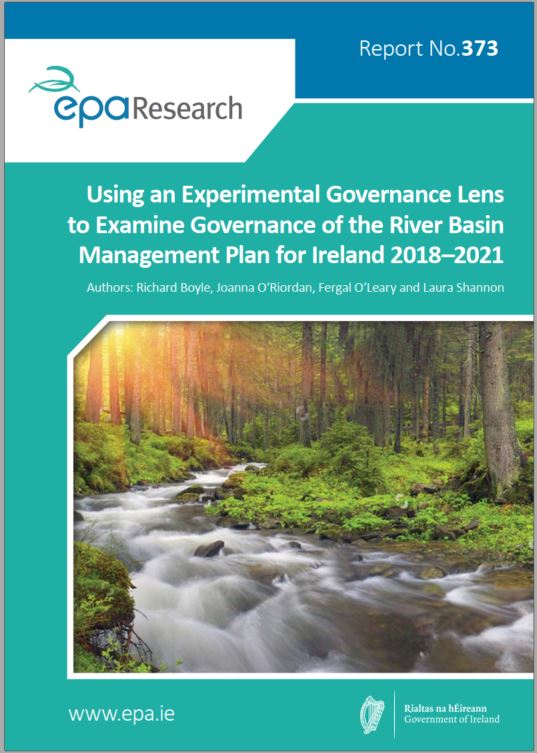Latest Research Publications

Research 382: Transitioning to Strategic Noise Mapping under CNOSSOS-EU (Noise-Adapt)
Authors: Enda Murphy, Jon-Paul Faulkner, Henry J. Rice and John Kennedy, June 2021
Year: 2021
In the European Union (EU), 113 million people are estimated to be exposed to noise pollution from transport sources and this is detrimental to their health and quality of life. This report addresses noise pollution from transport as a significant environmental pressure and public health concern by providing recommendations that assist with the practical implementation of revisions to the Environmental Noise Directive.

Research 381: An Irish Nutrient Platform to Underpin Sustainable Development
Authors: Vincent O’Flaherty, John McGrath, Dermot Hughes, Juan Castilla Archilla, Jose Antonio Pícon, Andrew Bartle, Therese Mahony, Katrina Macintosh and Etain Doherty, June 2021
Year: 2021
The UN Agenda for Sustainable Development consists of 17 Sustainable Development Goals (SDGs), underpinned by 169 targets, which aim to “end poverty, protect the planet and ensure prosperity for all”. These SDGs are expected to frame national policy agendas over the next 15 years in the context of both domestic and international policy, with an overarching desire to link environmental sustainability to sustainable economic development and the recognition that the management and protection of the environment are vital to economic wellbeing and a healthy society.

Research 380: Innovative Water Monitoring
Authors: Kevin Fitzgibbon, William Whelan-Curtin, Chinna Devarapu, Patricia Loren, Colin O’Sullivan and Ian Aherne, June 2021
Year: 2021
The Innovative Water Monitoring project aimed to create an additional innovative sensing system for real-time detection of water quality parameters, to support the existing water quality monitoring policies, programmes and requirements under the Water Framework Directive, the Bathing Water Quality legislation, etc. It has demonstrated the ability to detect two such parameters, nitrates and Escherichia coli (E. coli), using the system.

Research 379: Policy Coherence in Adaptation Studies: Selecting and Using Indicators of Climate Resilience
Authors: Stephen Flood, Ned Dwyer and Jeremy Gault, June 2021
Year: 2021
Adaptation action is now urgently needed to reduce the social, economic and environmental impacts of present and future climate change to ensure resilience to both extreme and slow-onset events under a changing climate. This project combines an analysis of international best practice and approaches to the development of climate adaptation indicators, co-designed by key stakeholder representatives from relevant state agencies and regional and national government, to identify a tailored suite of Ireland-relevant climate adaptation indicators. The co-design process identified a suite of 127 recommended indicators – 15 are climatological indicators, 23 are impact indicators, 32 are implementation indicators and 21 are outcome indicators. Ninety-one of these indicators were identified as priority.

National Environmental Policies For the EPA State of Environment Report 2020
Authors: Tadhg Coakley and Eileen O’Leary, June 2021
Year: 2021
In the recently published EPA report, Ireland's Environment 2020 - An Assessment, the need for an overarching environmental policy for the country was identified. This report examines national environmental policies across a number of countries, as well as a review of other related policies at an EU and international level.

Research 378: Towards the Quantification of Blanket Bog Ecosystem Services to Water
Authors: Raymond Flynn, Francis Mackin and Florence Renou-Wilson, June 2021
Year: 2021
Blanket bogs are common in many areas of Ireland, contributing to our most iconic landscapes. However, although they cover approximately 13% of the country, natural processes sustaining blanket bogs remain poorly understood. This research aimed to better understand blanket bog hydrology through a 3-year programme in which researchers monitored the flow and water quality in streams draining Irish blanket bogs that are relatively intact.

Research 377: Impacts of Microplastics in the Irish Freshwater Environment
Authors: Alicia Mateos-Cárdenas, Alexandra R.J. Jansen, John O’Halloran, Frank N.A.M. van Pelt and Marcel A.K. Jansen, June 2021
Year: 2021
Plastics are a key part of modern life, due to their desirable characteristics such as light weight and low cost. However, the extensive production of plastics is resulting in plastic pollution. This study recognises the risk posed by rapid formation of micro- and nanoplastics in the freshwater environment and advocates the rapid development of field-monitoring and impact studies to analyse hazards and risks posed by these plastics.

Research 376: From Source to Sink: Responses of a Coastal Catchment to Large-scale Changes (Golden Strand Catchment, Achill Island, County Mayo)
Authors: Eugene Farrell, Mary Bourke, Tiernan Henry, Gesche Kindermann, Kevin Lynch, Terry Morley, Barry O’Dwyer, John O’Sullivan and Jonathan Turner, June 2021
Year: 2021
This research is a series of field experiments that measured patterns in the sediment and water pathways in the Golden Strand catchment, Achill Island, County Mayo. The results show that climate changes (storminess, temperature, precipitation) impacts are site specific and require long-term, multi-disciplinary field monitoring programmes (geomorphology; ecology; hydrology) to capture local specificity and environmental variability.

EPA Research Project Communication
Year: 2021
This is a guide for EPA Research Project communications

Guidelines for EPA-Funded Research Project Twitter Accounts
Year: 2021
Guidelines for EPA-Funded Research Project Twitter Accounts

Research 375: Development of Quality Standards for Compost and Digestate in Ireland
Authors: Percy Foster and Munoo Prasad, May 2021
Year: 2021
In Ireland, there are no national end-of-waste criteria for compost and digestate derived from source-separated materials. This study developed a quality standard for digestate and an updated standard for compost, it also recommends a strategy on how Ireland should implement national end-of-waste criteria for compost and digestate. It also examined best practice in other countries and options for having end-of-waste criteria.

EPA Research Call 2021 Technical Description
Year: 2021

Research 374: Piloting Innovative Approaches in Sustainable Communities towards Achieving the United Nations Sustainable Development Goals in Ireland
Authors: Vincent Carragher and Hugh O’Reilly, May 2021
Year: 2021
This study set out to catalyse the sustainability transition of communities using the United Nations Sustainable Development Goals (SDGs) as a framework. The research had a branded, public-facing campaign, Spark Change (www.sparkchange.ie), which recruited communities to an SDG challenge, effectively asking and supporting them to progress their sustainability transition and related SDG actions.

Call Evaluation Process
Year: 2021


Research 373: Using an Experimental Governance Lens to Examine Governance of the River Basin Management Plan for Ireland 2018–2021
Authors: Richard Boyle, Joanna O’Riordan, Fergal O’Leary and Laura Shannon, May 2021
Year: 2021
This report examines lessons learned from the water governance arrangements put in place for the River Basin Management Plan (RBMP) 2018–2021 for Ireland through the lens of experimental governance. The study finds that the three-tier governance structure is appropriate and should be continued. However, there is still room for improvement in the area of adapting and improving the operation of the existing arrangements.

Research 372: Using the OECD Water Governance Indicator Framework to Review the Implementation of the River Basin Management Plan for Ireland 2018–2021
Authors: Joanna O’Riordan, Richard Boyle, Fergal O’Leary and Laura Shannon, May 2021
Year: 2021
This report assesses water governance in Ireland using the Water Governance Indicator Framework, a tool developed by the Organisation for Economic Cooperation and Development (OECD) in 2018 to assist countries in assessing their progress towards the European Union’s Water Framework Directive.

Research 371: Climate Change and Land Use in Ireland
Author: Eamon Haughey, May 2021
Year: 2021
Land supports a range of ecosystem services including biodiversity and economic outputs in the agriculture and forestry sectors. This report identified pressures in the land system by analysing land use and outputs and greenhouse gas emissions associated with the land system. It identifies knowledge gaps in relation to national land use mapping, which currently limit the potential for regional analyses of land–climate interactions.

